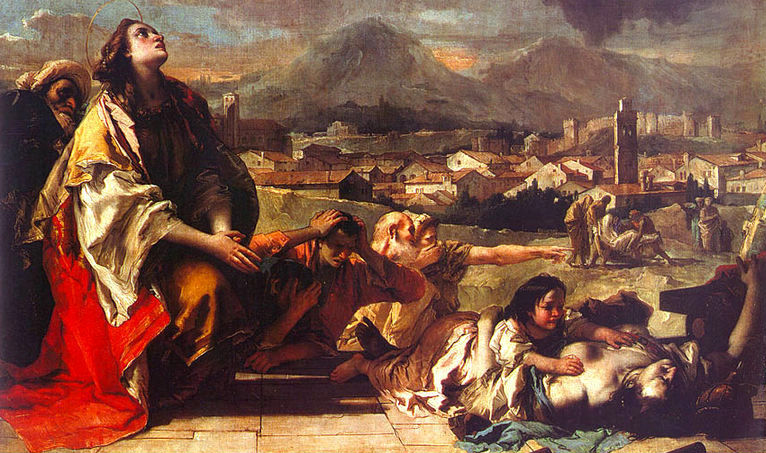Below, an abridged translation from the third volume of
Karlheinz Deschner’s Kriminalgeschichte des Christentums.
Most of the written statements about the martyrs are false, but all of them were considered as totally valid historical documents (3 of 7)
But precisely the bishops—whose martyrdom was considered ‘something special’ before that of ordinary Christians—very rarely were martyrs. They fled en masse, sometimes from one country to another, to the limits of the Roman Empire, naturally at the behest of God and without forgetting to send from a safe place letters of support to the lesser faithful who were left imprisoned. In the old Church this was so well known that even in numerous spurious accounts of martyrs there are few bishops who figure as martyrs! (The patriarch of Alexandria, Dionysus, was in such a hurry when a local pogrom broke out that he fled on the back of a cavalry devoid of a chair—he rightly bears the nickname ‘the Great’.)
But practically all of the ‘saints’ of the first centuries were later declared martyrs, ‘even if they had died peacefully. Anyone worthy of the veneration of Constantine had to be a martyr ‘(Kötting). Therefore, ‘very few’ of the Acta Martyrum are ‘true or based on real documentary material’ (Syme).
And especially after the 4th century Catholic Christians had records and accounts of martyrs that seemed forged by the ‘heretics’, so they ‘purified’ them by counterfeiting. Although they admitted the miracles of the apostles that the accounts related, they did not want to consider valid the ‘false doctrines’ that accompanied them.
In this way, orthodox counterfeiters such as the so-called Pseudo-Melitus, the Pseudo-Jerome, the Pseudo-Obadiah and others, provided counter-falsifications. Christian ‘martyrs’ acts did not recoil at any exaggeration, no lack of truth, no kitsch. Since the Church made no use of the martyrdom of the woman of the apostle and first pope, St. Peter, a tale transmitted by a Father of the Church, St. Thecla is considered the first martyr, although it is said that she escaped martyrdom by a miracle.
Giovanni Battista: St. Thecla Liberating a City from the Plague, 1759.
But Catholic martyrology is strictly documented with the martyrdom of Polycarp, even knowing the hour of his death, something almost unique in proto-Christian literature. However, the date is unknown. It is unknown either if it was under Marcus Aurelius or Antoninus Pius. In this ocular testimony of the death of a Christian martyr—the oldest text: a throughout falsified text with revisions and interpolations with pre-Eusebian and a post-Eusebian false annexes—, the holy bishop knows in advance the type of his death.
Upon entering the stadium he is encouraged by a voice from the sky: ‘Stand firm, Polycarp!’ Miraculously he is not burned at the stake, to which ‘especially the Jews’ throw firewood. All the flames burn in vain. The executioner must then finish him off, his blood extinguishes the fire and from the saint’s wound a pigeon ascends to the sky… These acts ‘arose little by little and in a fragmentary way’ (Kraft).
However, even in the 20th century, in the Catholic Lexikonfür Theologie und Kirche (Encyclopaedia of Theology and the Church) this story shines as ‘the most valuable testimony for the Catholic worship of saints and relics’. Even today, the brave martyr continues to be venerated, who, as befits a bishop, had previously fled several times and changed his hiding place: the Byzantine and Syrian Churches celebrate it on February 23, the Melkites on the 25th and the Catholics on January 26, and Polycarp continues to act as ‘patron saint against the pain of ears’.
Let us take a look at the Acts of the Persian Martyrs.
The Christians are heading en masse towards their execution ‘singing the psalms of David’. They smile as the executioner lifts the sword. All the teeth are ripped out and all the bones are grounded. New whips are bought on purpose. They are hit until only pulp is left of their bodies. Their joints are broken, they are skinned from head to toe, they are cut slowly from the middle of the neck to the skull, their noses and ears are cut, burning needles are stuck into their eyes, they are stoned, they are cut with a saw, they are left to starve until the skin falls from their bones. Once sixteen elephants step on the heroes…
But whatever it is, the martyrs tolerate almost everything for a surprisingly long time and with good cheer, so to speak, with joy. Being only blood and shredded flesh, they launch the most edifying discourses. They shout with joy: ‘My heart rejoices in the Lord and my soul rejoices in its bliss’. Or they recognise: ‘This suffering is only relief’.
______ 卐 ______
Liked it? Take a second to support this site.
